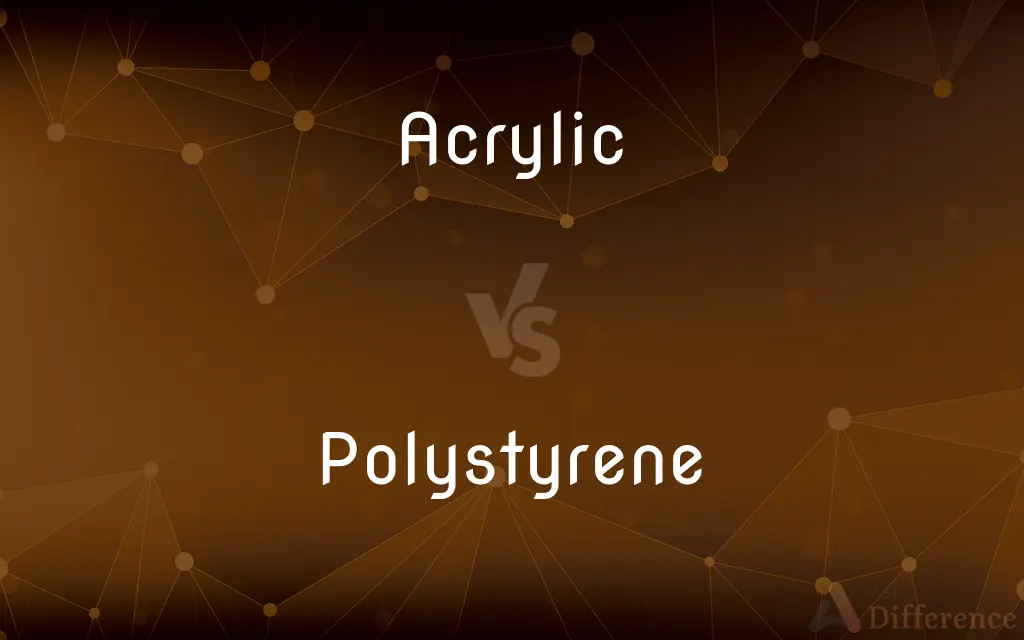Acrylic vs. Polystyrene — What's the Difference?
By Fiza Rafique & Urooj Arif — Updated on March 7, 2024
Acrylic is known for its clarity, strength, and UV resistance, ideal for transparent applications. Polystyrene, cheaper and more brittle, is preferred for cost-sensitive, non-load-bearing products.

Difference Between Acrylic and Polystyrene
Table of Contents
ADVERTISEMENT
Key Differences
Acrylic, often referred to by its chemical name polymethyl methacrylate (PMMA), boasts excellent optical clarity and durability, making it a popular choice for applications requiring transparency and resistance to weathering, such as aquariums and skylights. On the other hand, polystyrene, recognized for its ease of molding and lower cost, is commonly used in packaging, disposable containers, and model building, where strength and durability are less critical.
In terms of mechanical properties, acrylic stands out for its higher impact resistance compared to polystyrene, which is more prone to cracking under stress. This makes acrylic a better option for applications where safety and longevity are concerns, whereas polystyrene is chosen for its cost-effectiveness in applications where durability is not the main requirement.
When it comes to UV resistance, acrylic has a natural advantage, resisting yellowing and degradation under sunlight, suitable for outdoor uses. Polystyrene, while useful for indoor applications, tends to degrade and discolor when exposed to UV light, limiting its outdoor applications without additional protective coatings.
Environmental considerations also distinguish the two materials. Acrylic can be recycled more easily than polystyrene, which is often not recycled due to its low economic value and the challenges associated with its collection and processing. This makes acrylic a more environmentally friendly option in contexts where recycling and sustainability are prioritized.
From a manufacturing standpoint, both materials can be easily fabricated and molded into various shapes, but acrylic offers better bonding properties for adhesives and solvents, allowing for more complex assemblies. Polystyrene, while versatile, may require specialized adhesives and conditions for effective bonding, influencing material selection based on the complexity of the design.
ADVERTISEMENT
Comparison Chart
Optical Clarity
High clarity, remains clear over time.
Less clear, can become opaque with degradation.
Impact Resistance
Higher impact resistance, less likely to crack.
More brittle, prone to cracking under stress.
UV Resistance
Resistant to UV light, does not yellow easily.
Susceptible to UV degradation, requires protective coatings for outdoor use.
Environmental Impact
Easier to recycle, more environmentally friendly.
Difficult to recycle, often not recycled due to economic and logistic reasons.
Applications
Aquariums, skylights, protective barriers.
Packaging, disposable containers, model building.
Fabrication
Good bonding properties with adhesives, versatile in fabrication.
Requires specific adhesives for effective bonding, easily molded.
Compare with Definitions
Acrylic
Offers better impact resistance than many plastics.
Acrylic windows are less likely to shatter upon impact.
Polystyrene
A lightweight, cost-effective plastic used widely in packaging.
Polystyrene foam is commonly used for packing electronics.
Acrylic
Can be recycled, contributing to environmental sustainability.
Recycled acrylic is used in manufacturing eco-friendly products.
Polystyrene
Easily molded into various shapes for diverse applications.
Polystyrene cups are produced through efficient molding processes.
Acrylic
Known for its optical clarity and UV resistance.
Acrylic panels are preferred for outdoor applications to avoid yellowing over time.
Polystyrene
More brittle and less durable than acrylic.
Polystyrene models can break easily if dropped.
Acrylic
A transparent thermoplastic with high strength and resistance to weathering.
Acrylic sheets are used for aquarium walls due to their clarity and strength.
Polystyrene
Difficult to recycle, posing environmental challenges.
Most polystyrene waste ends up in landfills.
Acrylic
Versatile in application from protective barriers to decorative items.
Acrylic furniture offers a modern look with durability.
Polystyrene
Susceptible to UV degradation, limiting outdoor use.
Polystyrene products are mainly used indoors to avoid sunlight damage.
Acrylic
(of synthetic resins and textile fibres) made from polymers of acrylic acid or acrylates
A red acrylic jumper
Polystyrene
Polystyrene (PS) is a synthetic aromatic hydrocarbon polymer made from the monomer known as styrene. Polystyrene can be solid or foamed.
Acrylic
An acrylic textile fibre
A sweater in four-ply acrylic
Polystyrene
A rigid clear thermoplastic polymer of styrene that can be molded into objects or made into a foam that is used as thermal insulation.
Acrylic
An acrylic paint
Washes of white acrylic
She paints mainly in acrylics
Polystyrene
(organic chemistry) A vinylic polymer of styrene, CH2CHphenyl.
Acrylic
An acrylic resin.
Polystyrene
(organic chemistry) An alkane chain of benzene molecules, RCH2CHphenylR.
Acrylic
A paint containing acrylic resin.
Polystyrene
A polymer of styrene; a rigid transparent thermoplastic;
Expanded polystyrene looks like a rigid white foam and is used as packing or insulation
Acrylic
A painting done in acrylic resin.
Acrylic
Any of numerous synthetic fibers polymerized from acrylonitrile.
Acrylic
(organic chemistry) Derived from acrylic acid or acrylonitrile.
Acrylic
Containing an acrylic resin.
Acrylic
(organic chemistry) An acrylic resin.
Acrylic
(painting) A paint containing an acrylic resin.
When it comes to painting, I prefer using acrylics as my medium.
Acrylic
A painting executed using such a paint.
Acrylic
A thick sheet of plastic.
Acrylic
A liquid coating system based on an acrylic resin.
Acrylic
Of or containing acryl, the hypothetical radical of which acrolein is the hydride; as, acrylic acid. The characteristic residue in an acrylic compound is the carbonyl group attached directly to an ethylenic carbon.
Acrylic
Same as acrylic resin.
Acrylic
Same as acrylic fiber.
Acrylic
A paint in which the pigment is suspended in a solution of an acrylic resin, which dries to a hard film on exposure to air.
Acrylic
A painting made using an acrylic paint.
Acrylic
Polymerized from acrylonitrile
Acrylic
A glassy thermoplastic; can be cast and molded or used in coatings and adhesives
Acrylic
Used especially by artists
Acrylic
A synthetic fabric
Common Curiosities
What is acrylic used for?
Acrylic is used for applications requiring clarity, durability, and UV resistance, such as aquariums, skylights, and protective barriers.
How do acrylic and polystyrene differ in environmental impact?
Acrylic is easier to recycle and considered more environmentally friendly, while polystyrene recycling is challenging due to economic and logistic reasons.
How do the optical properties of acrylic and polystyrene compare?
Acrylic offers higher optical clarity and remains clear over time, whereas polystyrene can become opaque and degrade, especially under UV exposure.
What is polystyrene used for?
Polystyrene is used for packaging, disposable containers, and model building, where cost efficiency is more important than durability.
Why is acrylic preferred over polystyrene for outdoor applications?
Acrylic is preferred due to its superior UV resistance and durability, which prevent yellowing and degradation under sunlight.
Can polystyrene be used for load-bearing applications?
No, polystyrene is more brittle and less suitable for load-bearing applications compared to materials like acrylic.
Can acrylic and polystyrene be used together in products?
Yes, they can be used together, leveraging the strengths of each material in composite or multi-material products.
Is acrylic more expensive than polystyrene?
Yes, acrylic is generally more expensive than polystyrene due to its superior properties and manufacturing costs.
Are there recyclable alternatives to polystyrene for packaging?
Yes, there are more environmentally friendly alternatives, including recyclable plastics and biodegradable materials, though they may come with higher costs.
How does the fabrication flexibility of acrylic and polystyrene influence their application?
The ease of fabrication and bonding properties of acrylic make it suitable for complex structures, while polystyrene's moldability is ideal for mass-produced, simple items.
Can polystyrene be made UV resistant?
Yes, but it requires additional protective coatings or additives, increasing the cost and complexity of manufacturing.
Why is impact resistance important for certain applications?
High impact resistance is crucial for safety and durability in applications like vehicle windows, protective screens, and outdoor fixtures.
What makes acrylic a preferred material for protective barriers?
Its high impact resistance, clarity, and durability make it ideal for applications where safety and clear visibility are important.
How do manufacturing costs impact the choice between acrylic and polystyrene?
The choice depends on the application's requirements; polystyrene is chosen for cost-sensitive, non-critical items, while acrylic is selected for premium applications.
What advancements are being made in recycling polystyrene?
Advances include chemical recycling methods that break down polystyrene into its monomers for repurposing, aiming to improve its sustainability.
Share Your Discovery

Previous Comparison
Elaborative vs. Elaborate
Next Comparison
Guilty vs. InnocentAuthor Spotlight
Written by
Fiza RafiqueFiza Rafique is a skilled content writer at AskDifference.com, where she meticulously refines and enhances written pieces. Drawing from her vast editorial expertise, Fiza ensures clarity, accuracy, and precision in every article. Passionate about language, she continually seeks to elevate the quality of content for readers worldwide.
Co-written by
Urooj ArifUrooj is a skilled content writer at Ask Difference, known for her exceptional ability to simplify complex topics into engaging and informative content. With a passion for research and a flair for clear, concise writing, she consistently delivers articles that resonate with our diverse audience.














































